An In-Depth Examination of Risk Culture and Risk Attitude
VerifiedAdded on 2023/03/23
|10
|2025
|45
Report
AI Summary
This report examines the relationship between risk culture and risk attitude within an organization. It explores how employee attitudes, beliefs, and behaviors influence the overall risk culture, emphasizing the importance of leadership in shaping this culture through communication and setting the tone from the top. The report highlights the need for a robust risk culture to protect assets, prevent misconduct, and maintain a competitive advantage. Key best practices for a successful risk culture are discussed, including stakeholder involvement, clear communication, well-defined policies, and continuous monitoring. The report emphasizes that a strong risk culture involves all stakeholders and provides a framework for managing risk effectively, ultimately contributing to an organization's sustainability and success.

Risk culture and risk attitude 1
Risk Culture and Risk Attitude
Name
Course
Tutor
University
Date
Risk Culture and Risk Attitude
Name
Course
Tutor
University
Date
Paraphrase This Document
Need a fresh take? Get an instant paraphrase of this document with our AI Paraphraser
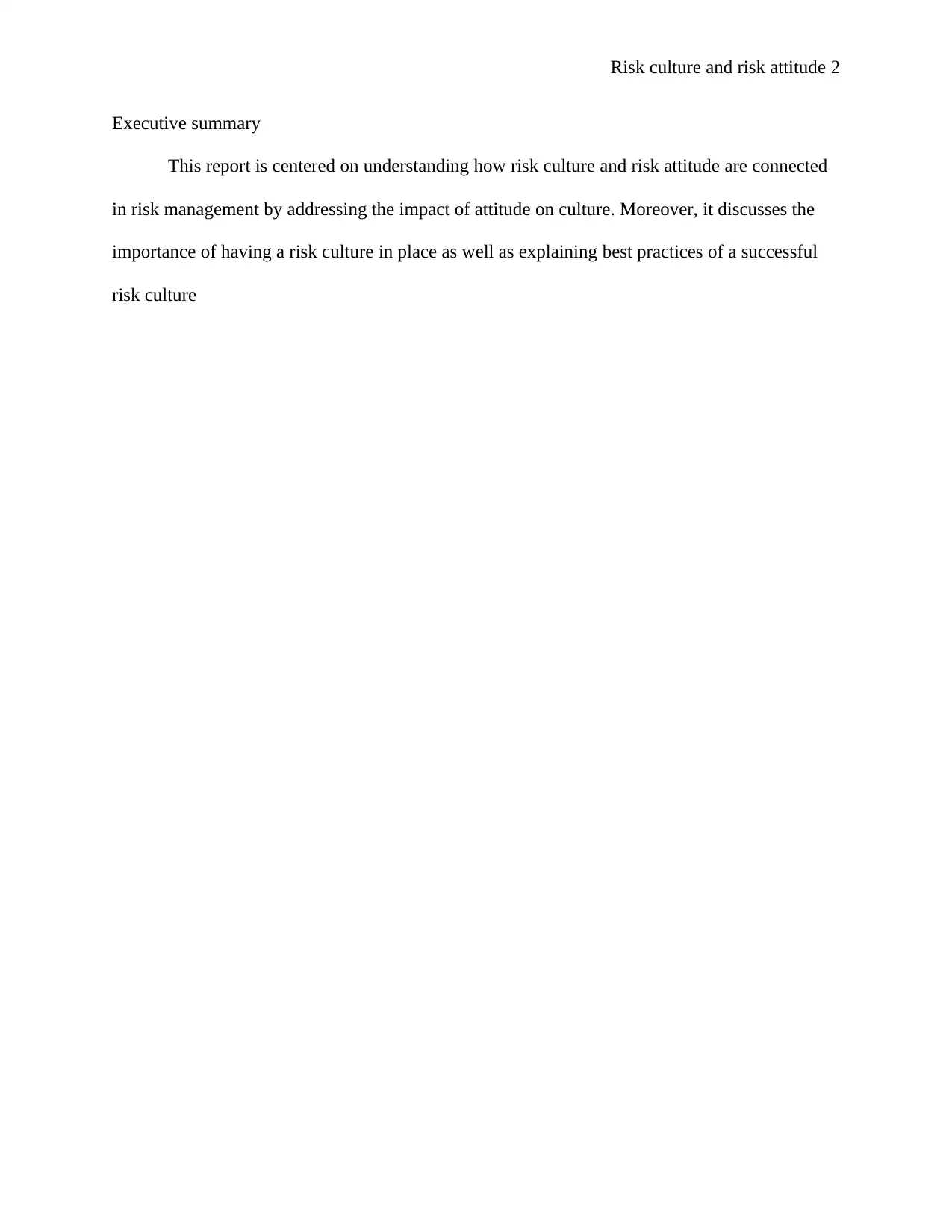
Risk culture and risk attitude 2
Executive summary
This report is centered on understanding how risk culture and risk attitude are connected
in risk management by addressing the impact of attitude on culture. Moreover, it discusses the
importance of having a risk culture in place as well as explaining best practices of a successful
risk culture
Executive summary
This report is centered on understanding how risk culture and risk attitude are connected
in risk management by addressing the impact of attitude on culture. Moreover, it discusses the
importance of having a risk culture in place as well as explaining best practices of a successful
risk culture
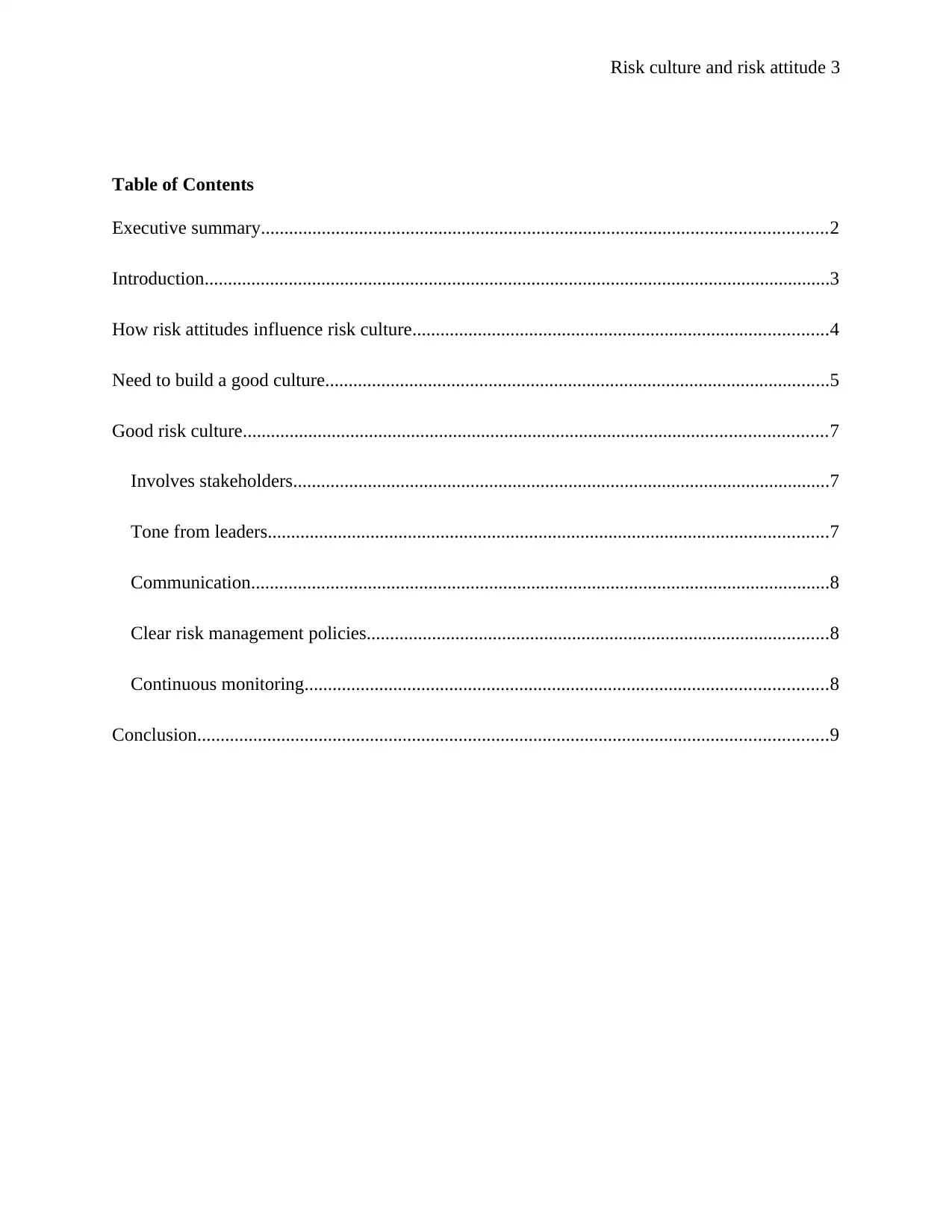
Risk culture and risk attitude 3
Table of Contents
Executive summary.........................................................................................................................2
Introduction......................................................................................................................................3
How risk attitudes influence risk culture.........................................................................................4
Need to build a good culture............................................................................................................5
Good risk culture.............................................................................................................................7
Involves stakeholders...................................................................................................................7
Tone from leaders........................................................................................................................7
Communication............................................................................................................................8
Clear risk management policies...................................................................................................8
Continuous monitoring................................................................................................................8
Conclusion.......................................................................................................................................9
Table of Contents
Executive summary.........................................................................................................................2
Introduction......................................................................................................................................3
How risk attitudes influence risk culture.........................................................................................4
Need to build a good culture............................................................................................................5
Good risk culture.............................................................................................................................7
Involves stakeholders...................................................................................................................7
Tone from leaders........................................................................................................................7
Communication............................................................................................................................8
Clear risk management policies...................................................................................................8
Continuous monitoring................................................................................................................8
Conclusion.......................................................................................................................................9
⊘ This is a preview!⊘
Do you want full access?
Subscribe today to unlock all pages.

Trusted by 1+ million students worldwide
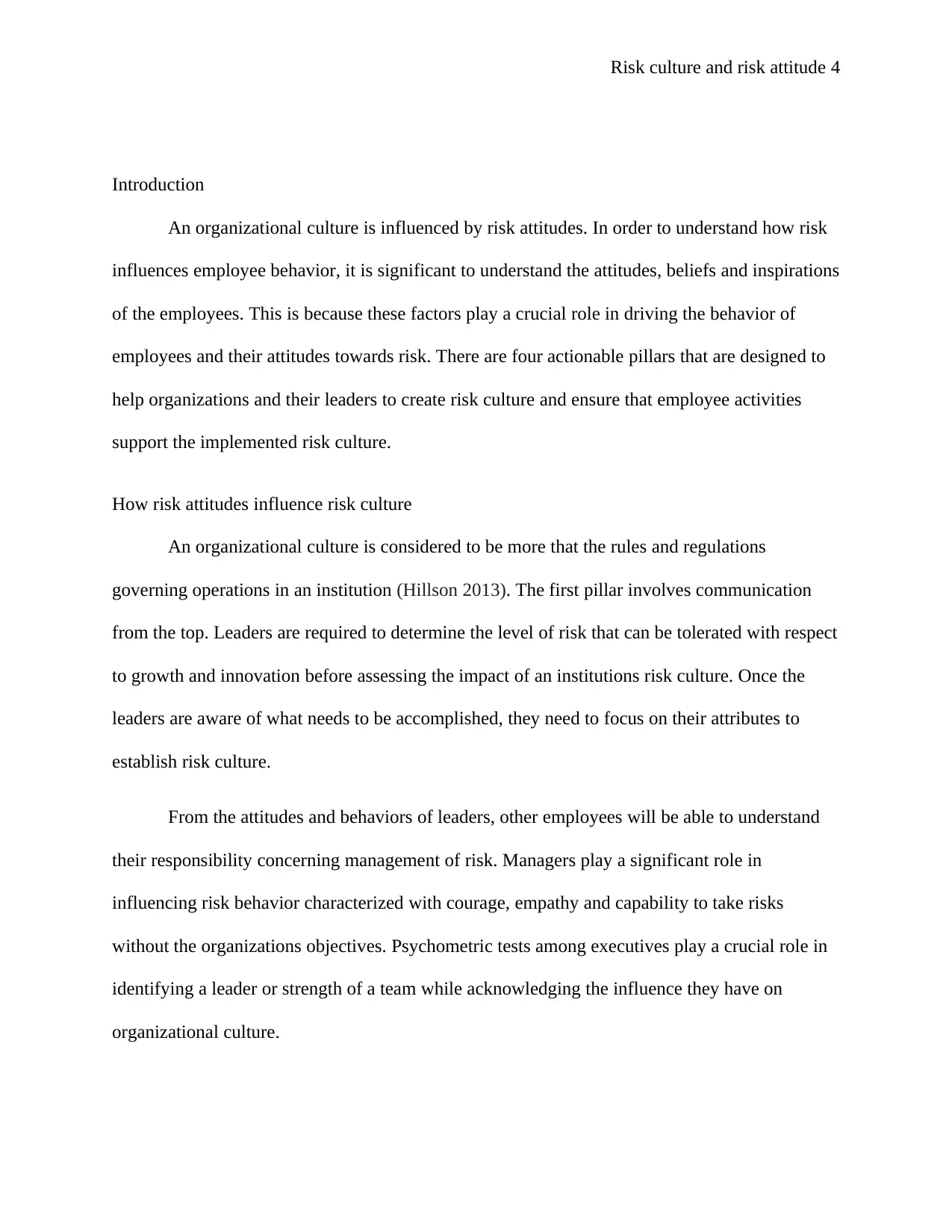
Risk culture and risk attitude 4
Introduction
An organizational culture is influenced by risk attitudes. In order to understand how risk
influences employee behavior, it is significant to understand the attitudes, beliefs and inspirations
of the employees. This is because these factors play a crucial role in driving the behavior of
employees and their attitudes towards risk. There are four actionable pillars that are designed to
help organizations and their leaders to create risk culture and ensure that employee activities
support the implemented risk culture.
How risk attitudes influence risk culture
An organizational culture is considered to be more that the rules and regulations
governing operations in an institution (Hillson 2013). The first pillar involves communication
from the top. Leaders are required to determine the level of risk that can be tolerated with respect
to growth and innovation before assessing the impact of an institutions risk culture. Once the
leaders are aware of what needs to be accomplished, they need to focus on their attributes to
establish risk culture.
From the attitudes and behaviors of leaders, other employees will be able to understand
their responsibility concerning management of risk. Managers play a significant role in
influencing risk behavior characterized with courage, empathy and capability to take risks
without the organizations objectives. Psychometric tests among executives play a crucial role in
identifying a leader or strength of a team while acknowledging the influence they have on
organizational culture.
Introduction
An organizational culture is influenced by risk attitudes. In order to understand how risk
influences employee behavior, it is significant to understand the attitudes, beliefs and inspirations
of the employees. This is because these factors play a crucial role in driving the behavior of
employees and their attitudes towards risk. There are four actionable pillars that are designed to
help organizations and their leaders to create risk culture and ensure that employee activities
support the implemented risk culture.
How risk attitudes influence risk culture
An organizational culture is considered to be more that the rules and regulations
governing operations in an institution (Hillson 2013). The first pillar involves communication
from the top. Leaders are required to determine the level of risk that can be tolerated with respect
to growth and innovation before assessing the impact of an institutions risk culture. Once the
leaders are aware of what needs to be accomplished, they need to focus on their attributes to
establish risk culture.
From the attitudes and behaviors of leaders, other employees will be able to understand
their responsibility concerning management of risk. Managers play a significant role in
influencing risk behavior characterized with courage, empathy and capability to take risks
without the organizations objectives. Psychometric tests among executives play a crucial role in
identifying a leader or strength of a team while acknowledging the influence they have on
organizational culture.
Paraphrase This Document
Need a fresh take? Get an instant paraphrase of this document with our AI Paraphraser
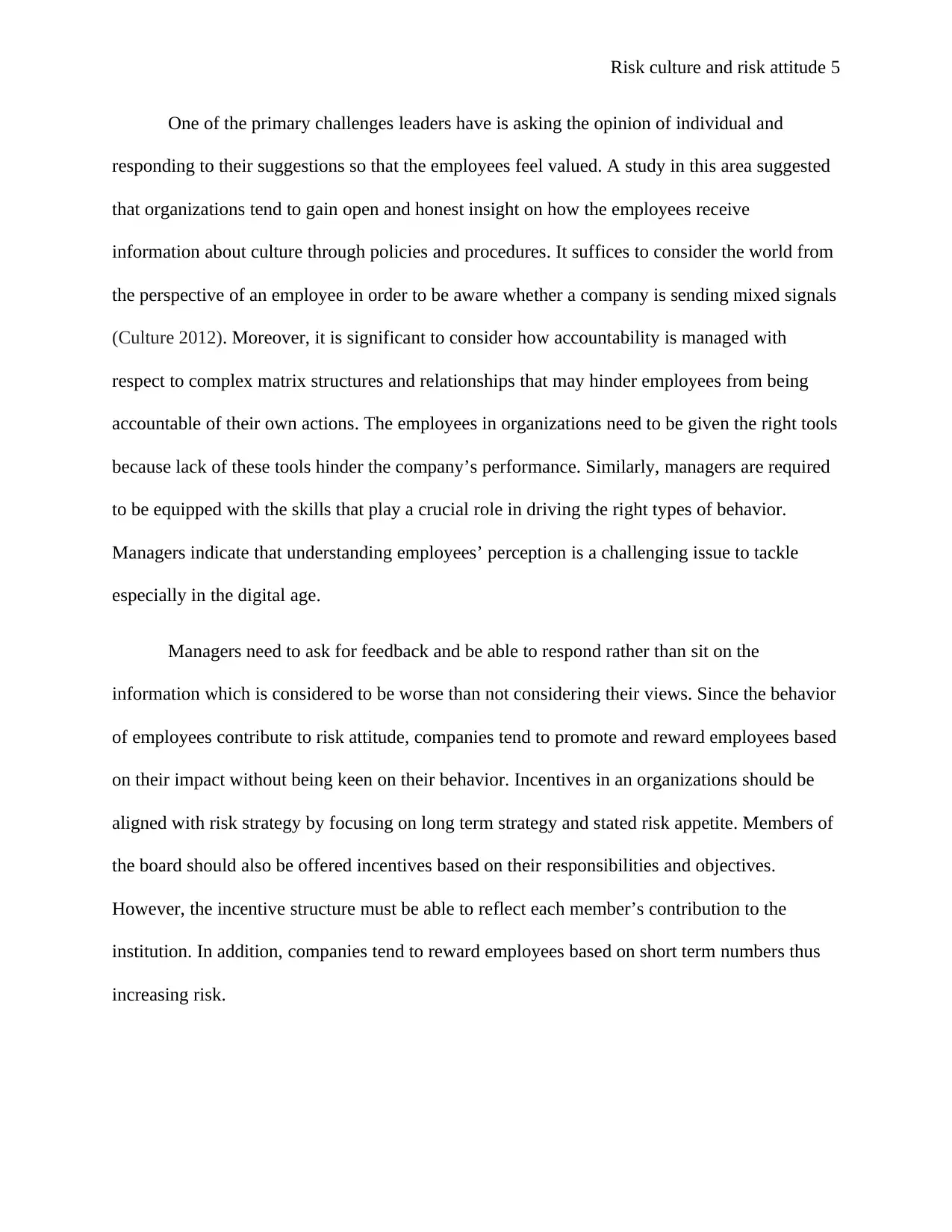
Risk culture and risk attitude 5
One of the primary challenges leaders have is asking the opinion of individual and
responding to their suggestions so that the employees feel valued. A study in this area suggested
that organizations tend to gain open and honest insight on how the employees receive
information about culture through policies and procedures. It suffices to consider the world from
the perspective of an employee in order to be aware whether a company is sending mixed signals
(Culture 2012). Moreover, it is significant to consider how accountability is managed with
respect to complex matrix structures and relationships that may hinder employees from being
accountable of their own actions. The employees in organizations need to be given the right tools
because lack of these tools hinder the company’s performance. Similarly, managers are required
to be equipped with the skills that play a crucial role in driving the right types of behavior.
Managers indicate that understanding employees’ perception is a challenging issue to tackle
especially in the digital age.
Managers need to ask for feedback and be able to respond rather than sit on the
information which is considered to be worse than not considering their views. Since the behavior
of employees contribute to risk attitude, companies tend to promote and reward employees based
on their impact without being keen on their behavior. Incentives in an organizations should be
aligned with risk strategy by focusing on long term strategy and stated risk appetite. Members of
the board should also be offered incentives based on their responsibilities and objectives.
However, the incentive structure must be able to reflect each member’s contribution to the
institution. In addition, companies tend to reward employees based on short term numbers thus
increasing risk.
One of the primary challenges leaders have is asking the opinion of individual and
responding to their suggestions so that the employees feel valued. A study in this area suggested
that organizations tend to gain open and honest insight on how the employees receive
information about culture through policies and procedures. It suffices to consider the world from
the perspective of an employee in order to be aware whether a company is sending mixed signals
(Culture 2012). Moreover, it is significant to consider how accountability is managed with
respect to complex matrix structures and relationships that may hinder employees from being
accountable of their own actions. The employees in organizations need to be given the right tools
because lack of these tools hinder the company’s performance. Similarly, managers are required
to be equipped with the skills that play a crucial role in driving the right types of behavior.
Managers indicate that understanding employees’ perception is a challenging issue to tackle
especially in the digital age.
Managers need to ask for feedback and be able to respond rather than sit on the
information which is considered to be worse than not considering their views. Since the behavior
of employees contribute to risk attitude, companies tend to promote and reward employees based
on their impact without being keen on their behavior. Incentives in an organizations should be
aligned with risk strategy by focusing on long term strategy and stated risk appetite. Members of
the board should also be offered incentives based on their responsibilities and objectives.
However, the incentive structure must be able to reflect each member’s contribution to the
institution. In addition, companies tend to reward employees based on short term numbers thus
increasing risk.
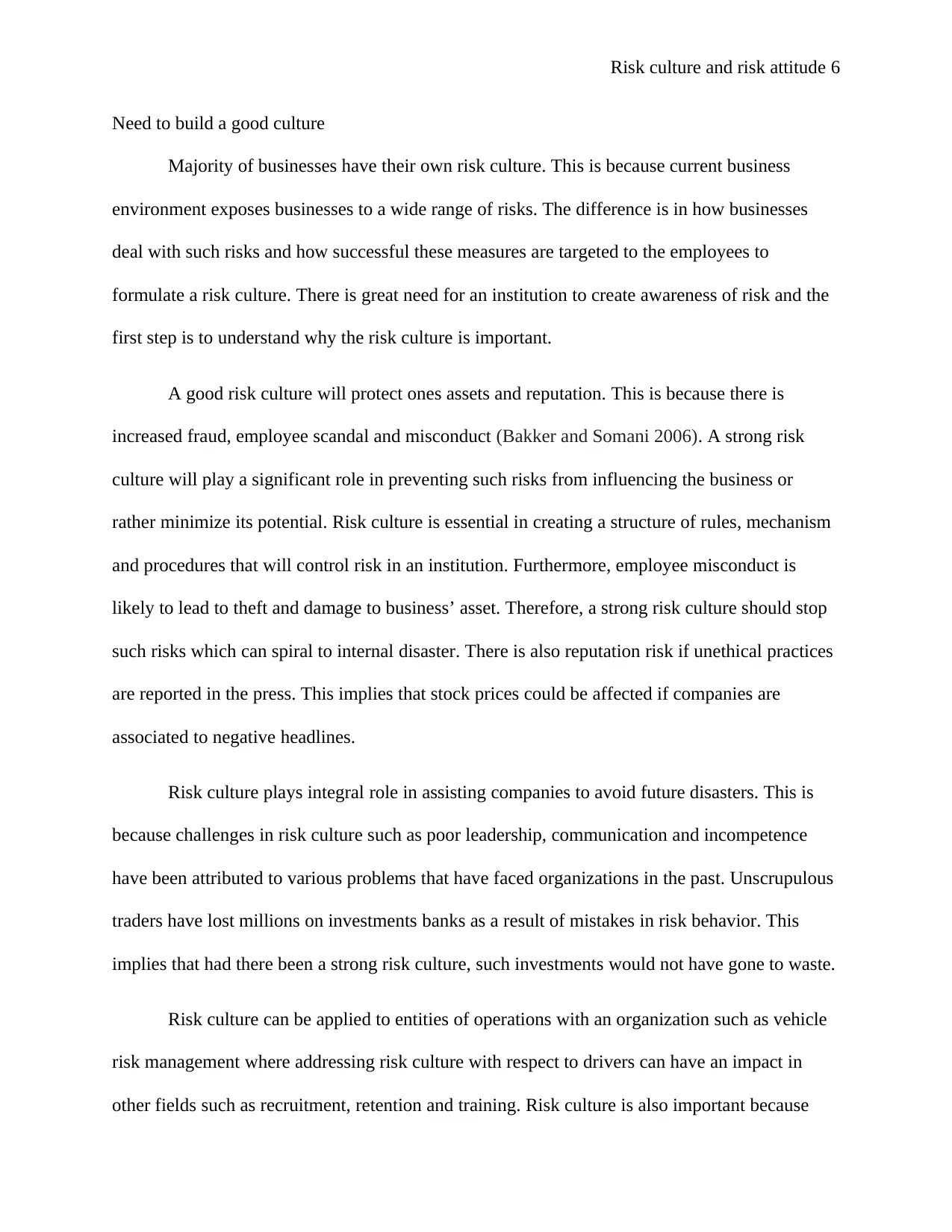
Risk culture and risk attitude 6
Need to build a good culture
Majority of businesses have their own risk culture. This is because current business
environment exposes businesses to a wide range of risks. The difference is in how businesses
deal with such risks and how successful these measures are targeted to the employees to
formulate a risk culture. There is great need for an institution to create awareness of risk and the
first step is to understand why the risk culture is important.
A good risk culture will protect ones assets and reputation. This is because there is
increased fraud, employee scandal and misconduct (Bakker and Somani 2006). A strong risk
culture will play a significant role in preventing such risks from influencing the business or
rather minimize its potential. Risk culture is essential in creating a structure of rules, mechanism
and procedures that will control risk in an institution. Furthermore, employee misconduct is
likely to lead to theft and damage to business’ asset. Therefore, a strong risk culture should stop
such risks which can spiral to internal disaster. There is also reputation risk if unethical practices
are reported in the press. This implies that stock prices could be affected if companies are
associated to negative headlines.
Risk culture plays integral role in assisting companies to avoid future disasters. This is
because challenges in risk culture such as poor leadership, communication and incompetence
have been attributed to various problems that have faced organizations in the past. Unscrupulous
traders have lost millions on investments banks as a result of mistakes in risk behavior. This
implies that had there been a strong risk culture, such investments would not have gone to waste.
Risk culture can be applied to entities of operations with an organization such as vehicle
risk management where addressing risk culture with respect to drivers can have an impact in
other fields such as recruitment, retention and training. Risk culture is also important because
Need to build a good culture
Majority of businesses have their own risk culture. This is because current business
environment exposes businesses to a wide range of risks. The difference is in how businesses
deal with such risks and how successful these measures are targeted to the employees to
formulate a risk culture. There is great need for an institution to create awareness of risk and the
first step is to understand why the risk culture is important.
A good risk culture will protect ones assets and reputation. This is because there is
increased fraud, employee scandal and misconduct (Bakker and Somani 2006). A strong risk
culture will play a significant role in preventing such risks from influencing the business or
rather minimize its potential. Risk culture is essential in creating a structure of rules, mechanism
and procedures that will control risk in an institution. Furthermore, employee misconduct is
likely to lead to theft and damage to business’ asset. Therefore, a strong risk culture should stop
such risks which can spiral to internal disaster. There is also reputation risk if unethical practices
are reported in the press. This implies that stock prices could be affected if companies are
associated to negative headlines.
Risk culture plays integral role in assisting companies to avoid future disasters. This is
because challenges in risk culture such as poor leadership, communication and incompetence
have been attributed to various problems that have faced organizations in the past. Unscrupulous
traders have lost millions on investments banks as a result of mistakes in risk behavior. This
implies that had there been a strong risk culture, such investments would not have gone to waste.
Risk culture can be applied to entities of operations with an organization such as vehicle
risk management where addressing risk culture with respect to drivers can have an impact in
other fields such as recruitment, retention and training. Risk culture is also important because
⊘ This is a preview!⊘
Do you want full access?
Subscribe today to unlock all pages.

Trusted by 1+ million students worldwide
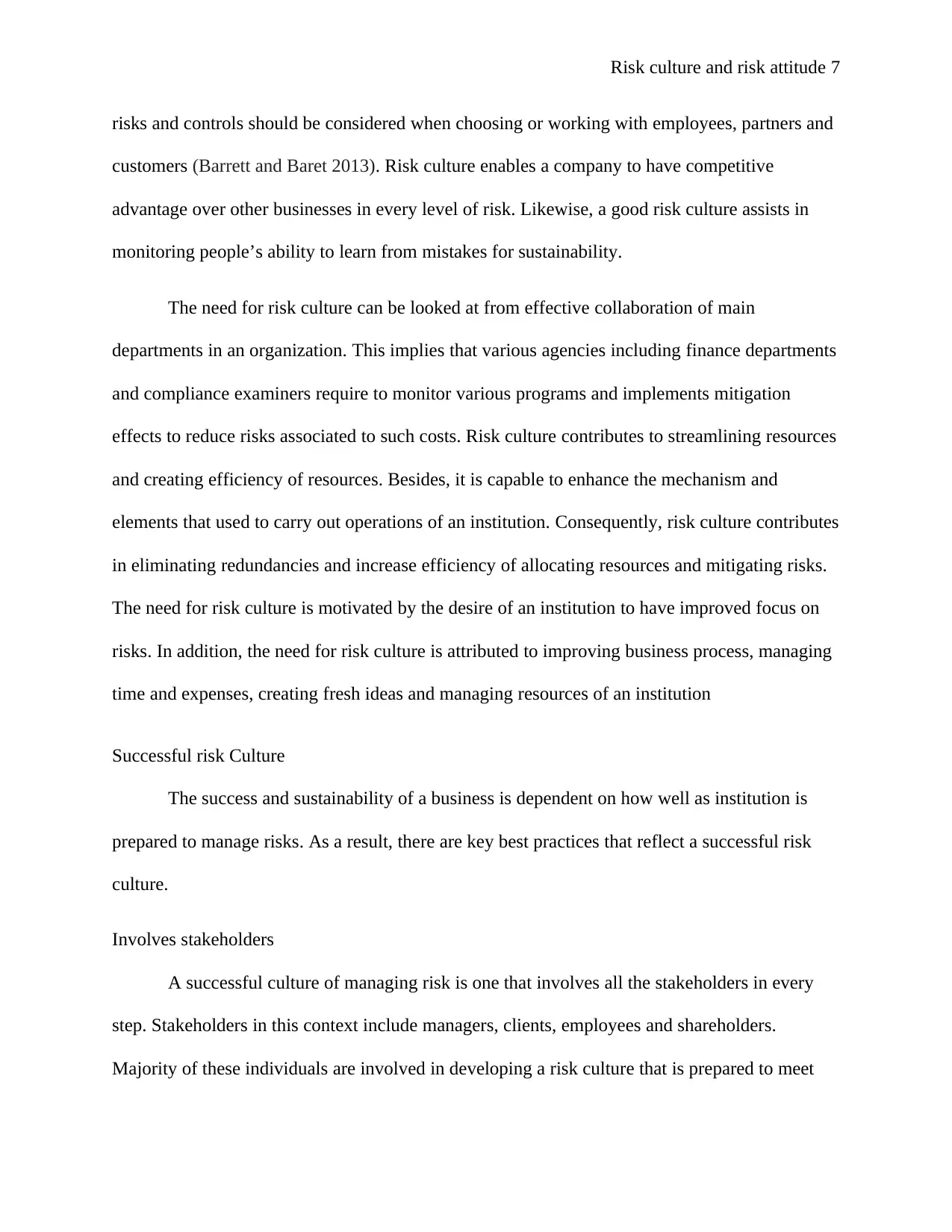
Risk culture and risk attitude 7
risks and controls should be considered when choosing or working with employees, partners and
customers (Barrett and Baret 2013). Risk culture enables a company to have competitive
advantage over other businesses in every level of risk. Likewise, a good risk culture assists in
monitoring people’s ability to learn from mistakes for sustainability.
The need for risk culture can be looked at from effective collaboration of main
departments in an organization. This implies that various agencies including finance departments
and compliance examiners require to monitor various programs and implements mitigation
effects to reduce risks associated to such costs. Risk culture contributes to streamlining resources
and creating efficiency of resources. Besides, it is capable to enhance the mechanism and
elements that used to carry out operations of an institution. Consequently, risk culture contributes
in eliminating redundancies and increase efficiency of allocating resources and mitigating risks.
The need for risk culture is motivated by the desire of an institution to have improved focus on
risks. In addition, the need for risk culture is attributed to improving business process, managing
time and expenses, creating fresh ideas and managing resources of an institution
Successful risk Culture
The success and sustainability of a business is dependent on how well as institution is
prepared to manage risks. As a result, there are key best practices that reflect a successful risk
culture.
Involves stakeholders
A successful culture of managing risk is one that involves all the stakeholders in every
step. Stakeholders in this context include managers, clients, employees and shareholders.
Majority of these individuals are involved in developing a risk culture that is prepared to meet
risks and controls should be considered when choosing or working with employees, partners and
customers (Barrett and Baret 2013). Risk culture enables a company to have competitive
advantage over other businesses in every level of risk. Likewise, a good risk culture assists in
monitoring people’s ability to learn from mistakes for sustainability.
The need for risk culture can be looked at from effective collaboration of main
departments in an organization. This implies that various agencies including finance departments
and compliance examiners require to monitor various programs and implements mitigation
effects to reduce risks associated to such costs. Risk culture contributes to streamlining resources
and creating efficiency of resources. Besides, it is capable to enhance the mechanism and
elements that used to carry out operations of an institution. Consequently, risk culture contributes
in eliminating redundancies and increase efficiency of allocating resources and mitigating risks.
The need for risk culture is motivated by the desire of an institution to have improved focus on
risks. In addition, the need for risk culture is attributed to improving business process, managing
time and expenses, creating fresh ideas and managing resources of an institution
Successful risk Culture
The success and sustainability of a business is dependent on how well as institution is
prepared to manage risks. As a result, there are key best practices that reflect a successful risk
culture.
Involves stakeholders
A successful culture of managing risk is one that involves all the stakeholders in every
step. Stakeholders in this context include managers, clients, employees and shareholders.
Majority of these individuals are involved in developing a risk culture that is prepared to meet
Paraphrase This Document
Need a fresh take? Get an instant paraphrase of this document with our AI Paraphraser
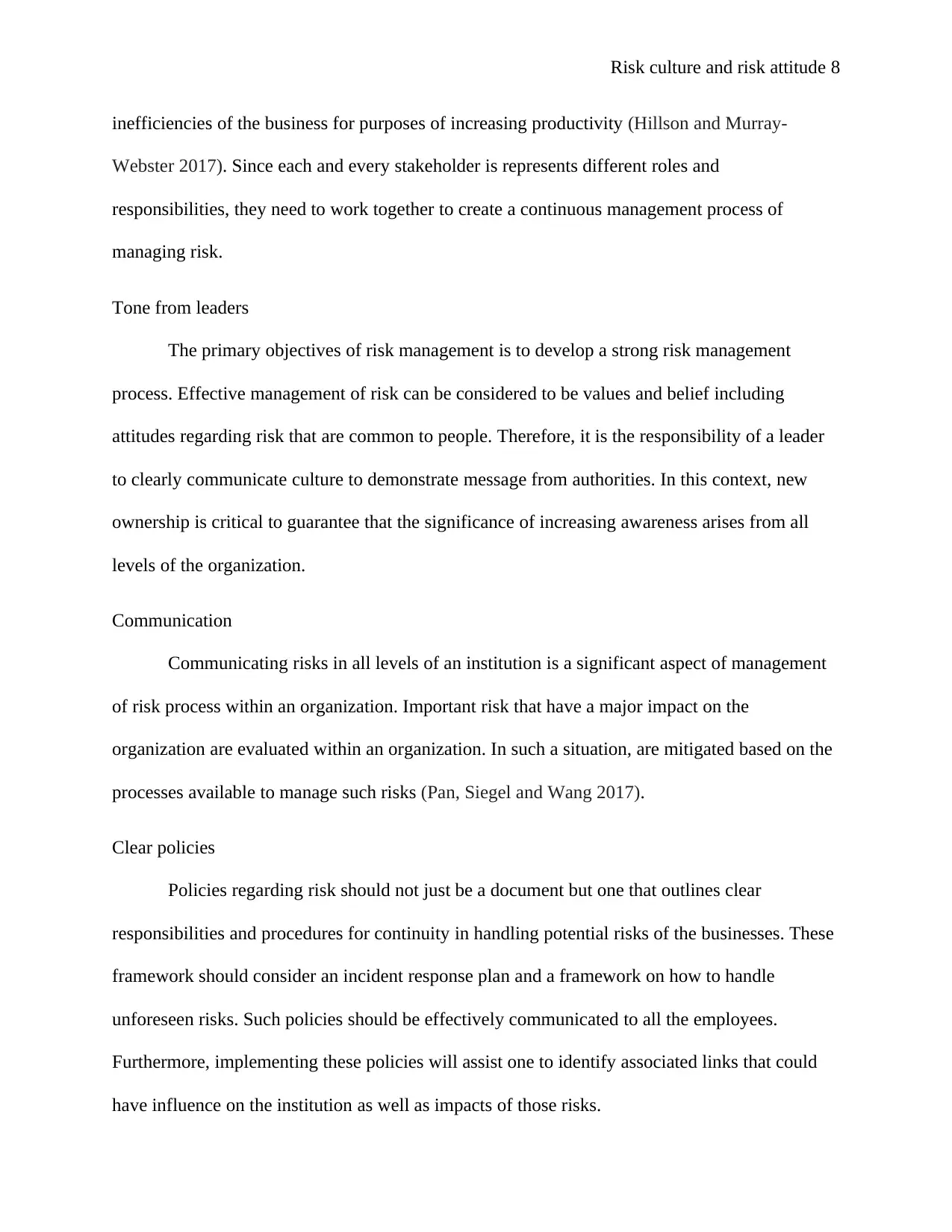
Risk culture and risk attitude 8
inefficiencies of the business for purposes of increasing productivity (Hillson and Murray-
Webster 2017). Since each and every stakeholder is represents different roles and
responsibilities, they need to work together to create a continuous management process of
managing risk.
Tone from leaders
The primary objectives of risk management is to develop a strong risk management
process. Effective management of risk can be considered to be values and belief including
attitudes regarding risk that are common to people. Therefore, it is the responsibility of a leader
to clearly communicate culture to demonstrate message from authorities. In this context, new
ownership is critical to guarantee that the significance of increasing awareness arises from all
levels of the organization.
Communication
Communicating risks in all levels of an institution is a significant aspect of management
of risk process within an organization. Important risk that have a major impact on the
organization are evaluated within an organization. In such a situation, are mitigated based on the
processes available to manage such risks (Pan, Siegel and Wang 2017).
Clear policies
Policies regarding risk should not just be a document but one that outlines clear
responsibilities and procedures for continuity in handling potential risks of the businesses. These
framework should consider an incident response plan and a framework on how to handle
unforeseen risks. Such policies should be effectively communicated to all the employees.
Furthermore, implementing these policies will assist one to identify associated links that could
have influence on the institution as well as impacts of those risks.
inefficiencies of the business for purposes of increasing productivity (Hillson and Murray-
Webster 2017). Since each and every stakeholder is represents different roles and
responsibilities, they need to work together to create a continuous management process of
managing risk.
Tone from leaders
The primary objectives of risk management is to develop a strong risk management
process. Effective management of risk can be considered to be values and belief including
attitudes regarding risk that are common to people. Therefore, it is the responsibility of a leader
to clearly communicate culture to demonstrate message from authorities. In this context, new
ownership is critical to guarantee that the significance of increasing awareness arises from all
levels of the organization.
Communication
Communicating risks in all levels of an institution is a significant aspect of management
of risk process within an organization. Important risk that have a major impact on the
organization are evaluated within an organization. In such a situation, are mitigated based on the
processes available to manage such risks (Pan, Siegel and Wang 2017).
Clear policies
Policies regarding risk should not just be a document but one that outlines clear
responsibilities and procedures for continuity in handling potential risks of the businesses. These
framework should consider an incident response plan and a framework on how to handle
unforeseen risks. Such policies should be effectively communicated to all the employees.
Furthermore, implementing these policies will assist one to identify associated links that could
have influence on the institution as well as impacts of those risks.
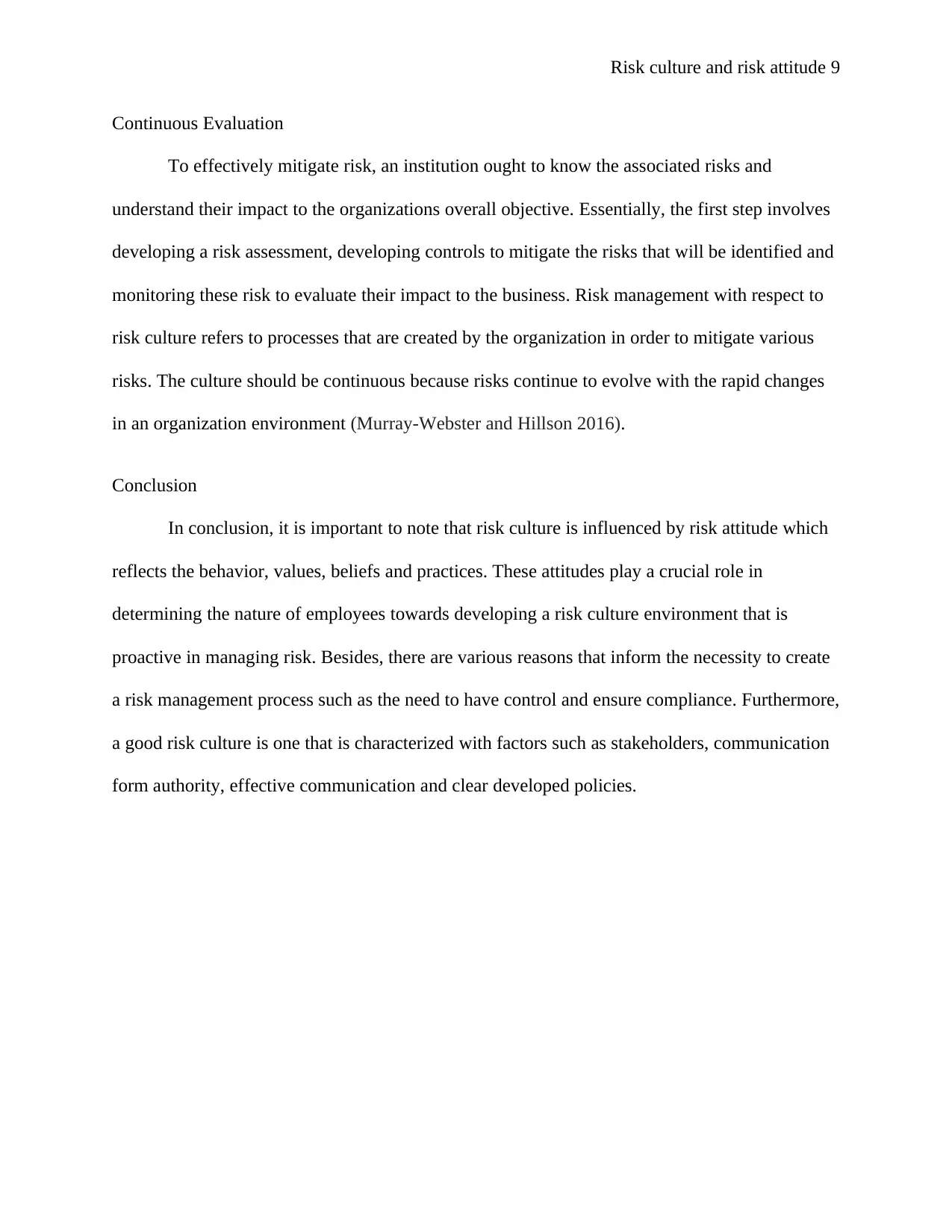
Risk culture and risk attitude 9
Continuous Evaluation
To effectively mitigate risk, an institution ought to know the associated risks and
understand their impact to the organizations overall objective. Essentially, the first step involves
developing a risk assessment, developing controls to mitigate the risks that will be identified and
monitoring these risk to evaluate their impact to the business. Risk management with respect to
risk culture refers to processes that are created by the organization in order to mitigate various
risks. The culture should be continuous because risks continue to evolve with the rapid changes
in an organization environment (Murray-Webster and Hillson 2016).
Conclusion
In conclusion, it is important to note that risk culture is influenced by risk attitude which
reflects the behavior, values, beliefs and practices. These attitudes play a crucial role in
determining the nature of employees towards developing a risk culture environment that is
proactive in managing risk. Besides, there are various reasons that inform the necessity to create
a risk management process such as the need to have control and ensure compliance. Furthermore,
a good risk culture is one that is characterized with factors such as stakeholders, communication
form authority, effective communication and clear developed policies.
Continuous Evaluation
To effectively mitigate risk, an institution ought to know the associated risks and
understand their impact to the organizations overall objective. Essentially, the first step involves
developing a risk assessment, developing controls to mitigate the risks that will be identified and
monitoring these risk to evaluate their impact to the business. Risk management with respect to
risk culture refers to processes that are created by the organization in order to mitigate various
risks. The culture should be continuous because risks continue to evolve with the rapid changes
in an organization environment (Murray-Webster and Hillson 2016).
Conclusion
In conclusion, it is important to note that risk culture is influenced by risk attitude which
reflects the behavior, values, beliefs and practices. These attitudes play a crucial role in
determining the nature of employees towards developing a risk culture environment that is
proactive in managing risk. Besides, there are various reasons that inform the necessity to create
a risk management process such as the need to have control and ensure compliance. Furthermore,
a good risk culture is one that is characterized with factors such as stakeholders, communication
form authority, effective communication and clear developed policies.
⊘ This is a preview!⊘
Do you want full access?
Subscribe today to unlock all pages.

Trusted by 1+ million students worldwide
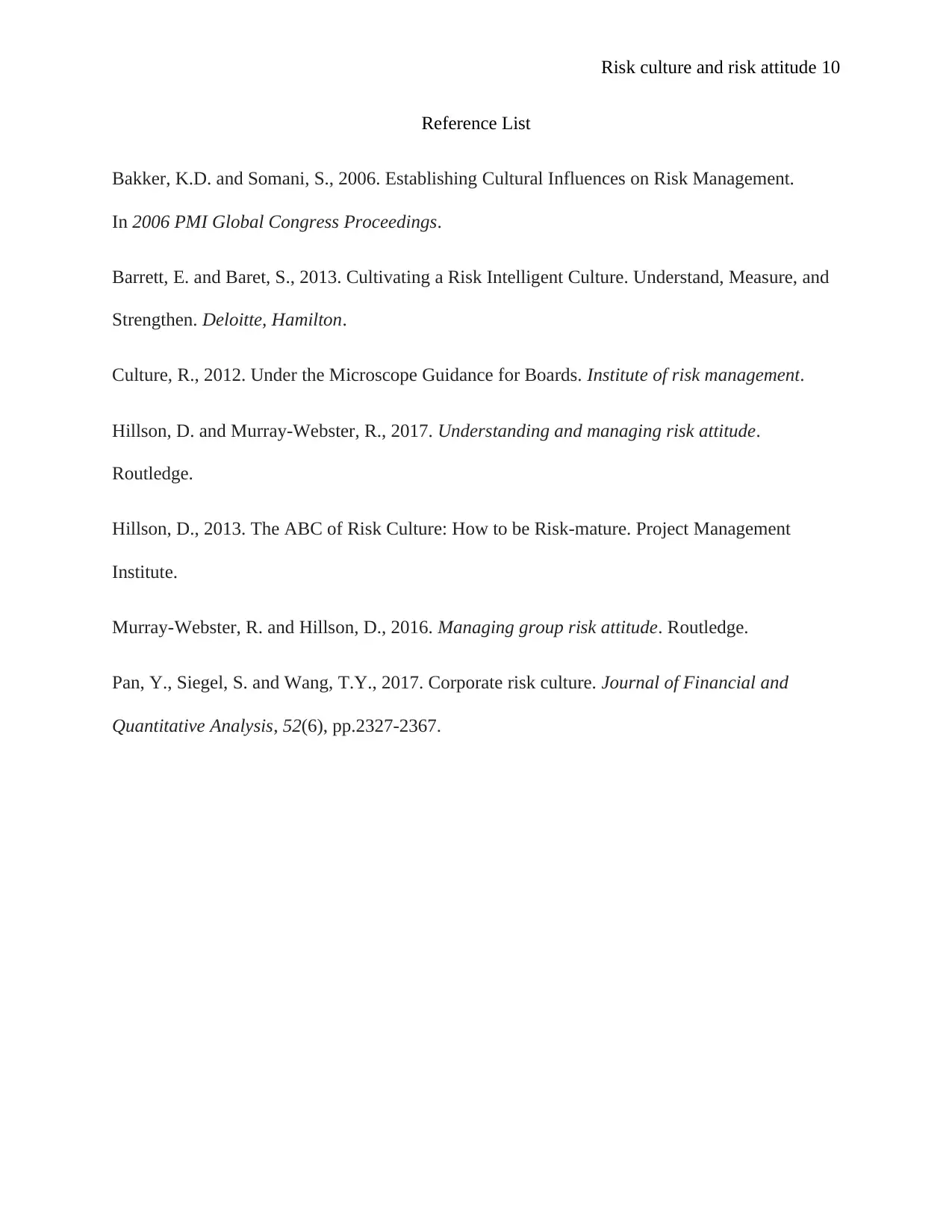
Risk culture and risk attitude 10
Reference List
Bakker, K.D. and Somani, S., 2006. Establishing Cultural Influences on Risk Management.
In 2006 PMI Global Congress Proceedings.
Barrett, E. and Baret, S., 2013. Cultivating a Risk Intelligent Culture. Understand, Measure, and
Strengthen. Deloitte, Hamilton.
Culture, R., 2012. Under the Microscope Guidance for Boards. Institute of risk management.
Hillson, D. and Murray-Webster, R., 2017. Understanding and managing risk attitude.
Routledge.
Hillson, D., 2013. The ABC of Risk Culture: How to be Risk-mature. Project Management
Institute.
Murray-Webster, R. and Hillson, D., 2016. Managing group risk attitude. Routledge.
Pan, Y., Siegel, S. and Wang, T.Y., 2017. Corporate risk culture. Journal of Financial and
Quantitative Analysis, 52(6), pp.2327-2367.
Reference List
Bakker, K.D. and Somani, S., 2006. Establishing Cultural Influences on Risk Management.
In 2006 PMI Global Congress Proceedings.
Barrett, E. and Baret, S., 2013. Cultivating a Risk Intelligent Culture. Understand, Measure, and
Strengthen. Deloitte, Hamilton.
Culture, R., 2012. Under the Microscope Guidance for Boards. Institute of risk management.
Hillson, D. and Murray-Webster, R., 2017. Understanding and managing risk attitude.
Routledge.
Hillson, D., 2013. The ABC of Risk Culture: How to be Risk-mature. Project Management
Institute.
Murray-Webster, R. and Hillson, D., 2016. Managing group risk attitude. Routledge.
Pan, Y., Siegel, S. and Wang, T.Y., 2017. Corporate risk culture. Journal of Financial and
Quantitative Analysis, 52(6), pp.2327-2367.
1 out of 10
Related Documents
Your All-in-One AI-Powered Toolkit for Academic Success.
+13062052269
info@desklib.com
Available 24*7 on WhatsApp / Email
![[object Object]](/_next/static/media/star-bottom.7253800d.svg)
Unlock your academic potential
Copyright © 2020–2025 A2Z Services. All Rights Reserved. Developed and managed by ZUCOL.




